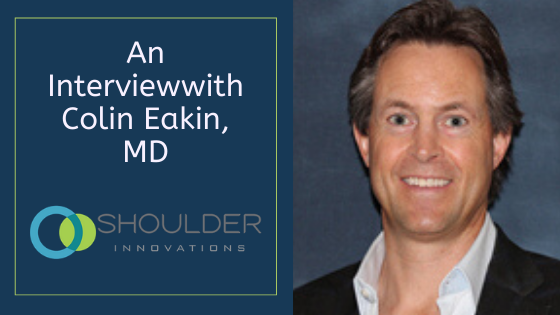We recently had the opportunity to meet with Colin Eakin, M.D., specifically to talk about his background and his experiences using the InSet™ Glenoid from Shoulder Innovations.
Dr. Colin Eakin is an Orthopedic Surgeon at Palo Alto Medical Foundation in California.
David Blue: Dr. Eakin, would you please share your background with us?
Dr. Eakin: I completed my undergrad at Stanford, UCSF Med School. UCSF residency. I then completed a one-year fellowship in Sports Medicine at the Steadman Hawkins Clinic in Vail, Colorado.
I’ve been here at Palo Alto Medical Foundation for 23 years doing Sports Medicine.
I’ve been the team physician for the San Francisco Giants (Major League Baseball Team), team physician for the San Jose Earthquakes (Major League Soccer Team), and I’ve been the head team physician for Stanford men’s basketball at various times during my career.
David Blue: How did you first learn about the InSet™ Glenoid, and the Shoulder Innovations team?
Dr. Eakin:
As part of the Hawkins Shoulder Society, which all the alums from the Steadman Hawkins Clinic are, we have a meeting every year just to talk shoulders.
Several years ago, a friend of mine shared about how he was starting to evaluate InSet™ glenoids.
And we all now know from our experience that onlay glenoids are risky for loosening because perimeter loading of the humeral head against the prosthesis can rock it. If you’ve got a concave glenoid, you’re going to have a convex-matched surface, and a convex-matched surface is like a rocking horse so that it can rock itself loose and out.
And nobody hates loose glenoids more than I do, so was really intrigued by the InSet™ Glenoid studies because a lot of times in glenohumeral deformities, there are shallow glenoids that we must deal with.
So, I kept my ear to the ground, and then a friend of mine, Dr. Steve Gunther, who was a partner with Dr. Tom Norris, came out with this Shoulder Innovations, flat-back, InSet™ glenoid that seemed to address and answer all of these concerns and problems that we saw with glenoids.
Then I found out that Dr. Tom Norris was also using the InSet™ routinely, so I asked to see it, and then I began to use it. The more I used it, the more I really liked it! My patients have been doing great!
In fact, I even gave a talk at this year’s Hawkins Society on my experience with the InSet™ glenoid.
David Blue: What types of indications do you primarily use the InSet™ Glenoid with?
Dr. Eakin: When I first started using it, I thought, “Okay, glenoids under 60 years old that have a high possibility of loosening prior to the patient’s demise.” So that’s what I started using it for.
But now I’m really starting to expand the use of it, doing more in the older-class patients and the more deformed class. Basically, anybody who I think is going to have a really hard glenoid; I’m doing the InSet™ on these patients as well, and I continue to expand my indications.
David Blue: If you were sitting down with a fellow surgeon to talk to them about this technology for the very first time, what would you tell them?
Dr. Eakin: Well, the exposure is very similar to the Tornier system that I have used for 23 years, but I find the InSet™ to be much easier to do.
I first try to retain most of the labrum because I know I’m only going to go out to the perimeter of the glenoid with the reaming. So, I try to preserve most of the labrum, but sometimes you must take some of the labrum just for exposure purposes. I think it can also help possibly be a stabilizer. I don’t think it has much neurological enervation, so I don’t think it’s going to be a pain generator.
The next thing I’d say is, if you’ve got that retroverted glenoid, it’s going to be a little bit of work to get the proper exposure, but it would be work, anyway, as you would still have to do end-on reaming a lot of times with the other systems to put an onlay glenoid in.
Then, in terms of sizing, you should try and size it such so that you leave a one or two-millimeter bone rim bumper around the perimeter. I think there’s a slight tendency to want to oversize and that’s not the goal.
In summary, the InSet™ glenoid has been absolutely great. I’ve had excellent success with it so far, even though some of my cases are a little shorter term than others who have had more longer-term results.
I’ve been sharing this with my patients, on how I’ve changed my technology on this over the last year, and walk them through the rationale. And I give them the option. I say, “Well, I could do the standard that I’ve always used,” but I tell them, “If I were you and I had your type of glenoid, I would do one of these flat-back InSet™ glenoids.”

